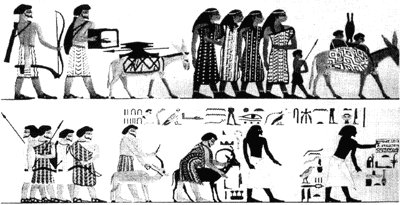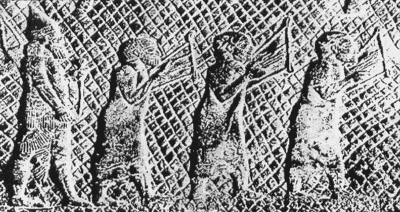Jews and Music The Legacy of Jubal
Fact Paper 8
© Samuel Kurinsky, all rights reserved

The Legacy of Jubal
Jubal, we are informed in Genesis IV:21, "was the father of all such as handle the harp and the organ."
Here is a remarkable circumstance! Immediately after Cain and Able were assigned to provide sustenance through agronomy and husbandry, human beings, through Jubal, are called upon to provide music!
Music is the spiritual form of communication. It is the most abstract aspect of human creativity, with the exception of mathematics, of which discipline music is but an aural expression.
The creation of music is the most exalted of divine activities. The musical essence of divinity is apparent in the instructions given Moses to express His presence in music. "Now therefore," God decrees to his earthly messenger, "write ye this song for you, and teach it to the children of Israel, put it into their mouths, that this song may be a witness for me."1
The Jews have sung His words ever since.
Music saturates the biblical life of the Jews. From the beginning, "singers," the biblical term that encompasses all forms of musical expression, vocal and instrumental, are integral to Jewish life and activity. Moses is ordered by God to make two trumpets of silver, precious instruments to be used to call together an assembly of the princes, to sound an alarm, to direct the movement of the troops, to summon the protection of the Lord in war, and to call together the entire congregation. Furthermore, trumpets are to be provided to the sons of Aaron, the priests, "and they shall be an ordinance forever throughout your generations."
Te centrality of music in Judaic culture, and the unique literacy of the Jewish people, combined to make them pioneers in the three facets of music: instrumentation, modality and notation.
Instrumentation
The Bible offers the richest repertory of musical instruments extant in ancient literature.
Musical instruments are classified into aerophones (which produce music by the forceful passage of air); chordophones which produce music with the vibration of taut strings); idiophones and their cousins the membranophones (which produce music by scraping, beating, clapping or jingling).
The biblical aerophone catalogue includes the woodwinds: alamoth, chalil, mahol, masrochit, neginoth, negev, sumphania, ugab; the horns: trumpet, shofar, geren and yobel; and the organ: the magrephah.
The Chalil (chalalu) was one of the most beloved of biblical aerophones. Its very name is an endearing one from the Hebrew root word for "sweet." The Talmud is explicit about its origin: The pipe is called the chalil because its sound is so sweet."
The chalil was a double reed pipe whose counterpart is the oboe. The instrument was introduced into Egypt from Canaan during the two centuries of the so-called "Second Intermediate Period," in which six successive Semitic kings ruled Egypt (17th-15th c. bce. One king was named Jacob!)
The Greeks adopted the chalil and its name. Lacking the hard ch sound, and adding the Greek ending os, they transcribed chalalu into aulos!
The magrephah, the original organ, is described in the Talmud (Arachin tractate) as a bellows-operated pipe-organ with ten different sized reed-pipes, all pierced with ten holes and keyed to a reverberatory box. The magrephah emitted "all the hundred sounds of which our rabbis speak."2
The Babylonian Bible (Tamid tractate), describes one of its uses: A Levite musician "took the Magrephah and sounded it¼ The priest who heard its sound knew that his brother Levites had entered to sing, and he hastened to come."
The destruction of the Second Temple brought about a ban on the use in services of musical instruments giving forth "joyful sounds." Among the many Judaic musical practices the Christians carried on was the use of the organ. Ironically, some early church fathers campaigned to ban the use of this "Jewish instrument" because it would seduce Christians to the ‘hated religion’" – Judaism!3
Biblical chordophones include the lyres: Asor, kinnor (David’s "harp" was really a lyre), susan and qatros’ the harps: gittit, nebel; the lutes: neginoth, sabhah; the zither: pesanter. There was also the shemineth, and instruments called minnim (translating to "stringed instruments"), of which little is known.
The lyre, lute, and harp were, like the Chalil, introduced into Egypt by Semites. Such an event was immortalized on the wall of a tomb of an Egyptian baron. 37 Semitic traders, artisans and musicians are shown arriving with a lyre, metalworking tools, and rare goods. The chieftain of the group is identified hieroglyphically by the name Abushei (also the name of one of David’s head generals).4
The lyre was favored by the Greeks. They adopted the instrument and its name from the Jews, transliterating kinnor to kinyra. The 10-stringed lyre, the nebel, became the Greek psalterion (psaltery).
The idiophones are represented in the Bible by he cymbals: meziltaim, tzilzlim, selselim; the sistrums (metal rattles): shalishum; and other rattles: Menaaneim; bells: paanonim, mezillot. Related membranophones include drums and timbrels, such as the biblical top.
The word "drum" is a curious example of the process by which Hebrew musical terms infiltrated western languages. Top (plural tuppim), is a vocal simulation of the sound produced by beating a taut-skinned instrument. The Hebrew root is easily discerned in the early Greek work typanon, and in its later form tympanon. From the Greek the word insinuated into the Latin tympanum, and ends in the English words timbrel, tambourine, tabret, and timbre. Along the way the word detours into the Low German trumme, the Dutch trommel and drummel, and enters English as drum.
As trumme passes into Middle High German it is confused with the word for a wind instrument – it passes from trumme into Old High German as trumba and trumpa, arriving into English as trumpet!
Cymbals were used to mark the beginning, endings and pauses in the biblical chapters as they were sung. The use of cymbals were replaced by finger-signs, which in turn became imitated in writing and formed the first written notation system.

Notation
The signs were first reduced to writing by marks imitating the position of the fingers, and codified in the latter half of the ninth century in the Yeshiva at Tiberius by the eminent grammarian Aaron ben Asher. It is referred to aptly as the "Tiberius System." Another scholar, Ben Naftali, shortly produced another codal system..5
The Tiberius System was taken up by both eastern and western church musicians at the end of the tenth century.6 The Christian signs were virtual duplicates of the Hebraic scriptural notation system.
Modality
The Davidic contribution to the world of western music is incomparable. According to the Bible, 288 Levite families were divided into 24 guild-like associations, characterized by the type of instruments! 4000 Levites with musical aptitudes were commissioned to "praise the Lord with instruments."
The superscriptions in the Book of Psalms provided for half the 150 hymns specify the form of cantillation and musical accompaniment to be used. They "became the adored and incessantly imitated standards of western civilization."7
All the forms of the rendition of music in the Hebrew liturgy were adopted into the church service: the simple Psalmody) chanting of psalms by the cantor); the response (the division of the verses between the Chazan and the congregation; the antiphone (the division of responders into two groups); the litany (the repetition of fixed phrases or verses by the respondents.
Hebraic modality was used by the first Christian communities near Antioch in Syria. Particularly popular were emulations of Hebraic psalters by Bardesanes, put to music by his son Harmonius. The melodies were so "catchy" that "the populace became enamored of them. As people hummed them, they repeated the heretical texts of Bardesanes."
The Christians of Antioch, particularly the women, also loved to attend Jewish services and listened enraptured. Christian polemicists bitterly denounced this inimical behavior.8 The Church counterattacked by promoting the work of Ephraim, who "wrote poems as contrafacta to Harmonius’ tunes," (new texts to familiar songs, like "My country ‘tis of thee" to the tune of "God Save the King").
Cecil Roth summarizes the plagiarism of Hebraic musical modality: "Both the Byzantine ecclesiastical chant in the East¼and the pre-Gregorian chant in the West¼derive from that of the Syrian and Palestinian Church, which in turn had inherited the tradition if the synagogue.9
Eric Werner agrees, and cites two authorities of the Gregorian chant, the Priests Peter Wagner and Father Dechevrens, the latter stating plainly that "the Gregorian chant is the music of the Hebrews."10
The great Jewish poet Immanuel of Rome asks rhetorically, "What does the art of music say to the Christians", and answers, "indeed, I was stolen out of the land of the Hebrews (Gen.40:15)."
Notes
Note: Historical Jewish musicology is covered in A. Z. Idelsohn, Jewish Music in its Historical Development, (1929) reprinted by Schocken Books, NY, 1975. Much information has since come to the fore through archaeology and otherwise, but Idlesohn’s remains the most valuable work on the subject.
- Deuteronomy I: 17-30
- Nathan Ausubel, ed. "Musical Instruments in the Bible," The Book of Jewish Knowledge, 1964, pp.319-311
- Ausubel, Ibid., p.311.
- Samuel Kurinsky, "The Transformation of Egypt Under Canaanite Rule," The Eighth Day; The Hidden History of the Jewish Contribution to Civilization, Jason Aronson Inc., 1994, ch.5, pp.113-128.
- Ausubel, Ibid., pp.308-9
- Milus Velimirovic, "Christian Chant in Syria, Armenia, Egypt and Ethiopia," The New Oxford History of Music, Vol. II, 1990, p.27.
- Eric Werner, "The Jewish Contribution to Music," The Jews; Their Role in Civilization, ed., Louis Finkelstein, 1949, p.117.
- Andrew Sharf, Byzantine Jewry, 1971, pp.33-34.
- Cecil Roth, The Jewish Contribution to Civilization, 1956, p.21.
- Werner, Ibid., p.130.
